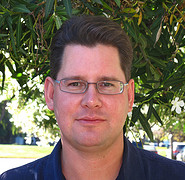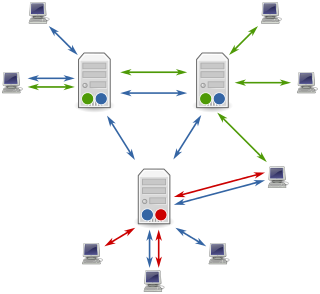
Lynx is a customizable text-based web browser for use on cursor-addressable character cell terminals. As of 2023, it is the oldest web browser still being maintained, having started in 1992.
A Usenet newsgroup is a repository usually within the Usenet system, for messages posted from users in different locations using the Internet. They are discussion groups and are not devoted to publishing news. Newsgroups are technically distinct from, but functionally similar to, discussion forums on the World Wide Web. Newsreader software is used to read the content of newsgroups.
rn is a news client written by Larry Wall and originally released in 1984. It was one of the first newsreaders to take full advantage of character-addressable CRT terminals. Previous newsreaders, such as readnews, were mostly line-oriented and designed for use on the printing terminals which were common on the early Unix minicomputers where the Usenet software and network originated. Later variants of the original rn program included rrn, trn, and strn.

A news server is a collection of software used to handle Usenet articles. It may also refer to a computer itself which is primarily or solely used for handling Usenet. Access to Usenet is only available through news server providers.
The Network News Transfer Protocol (NNTP) is an application protocol used for transporting Usenet news articles (netnews) between news servers, and for reading/posting articles by the end user client applications. Brian Kantor of the University of California, San Diego, and Phil Lapsley of the University of California, Berkeley, wrote RFC 977, the specification for the Network News Transfer Protocol, in March 1986. Other contributors included Stan O. Barber from the Baylor College of Medicine and Erik Fair of Apple Computer.
In the Unix operating system, shar is an archive format created with the Unix shar utility. A shar file is a type of self-extracting archive, because it is a valid shell script, and executing it will recreate the files. To extract the files, only the standard Unix Bourne shell sh is usually required.

B News was a Usenet news server developed at the University of California, Berkeley by Matt Glickman and Mary Ann Horton as a replacement for A News. It was used on Unix systems from 1981 into the 1990s and is the reference implementation for the de facto Usenet standard described in RFC 850 and RFC 1036. Releases from 2.10.2 were maintained by UUNET founder Rick Adams.

Richard J. Skrenta Jr. is an American computer programmer and Silicon Valley entrepreneur who created the web search engine blekko.
X-No-Archive, also known colloquially as xna, is a newsgroup message header field used to prevent a Usenet message from being archived in various servers.

slrn is a console-based news client for multiple operating systems, developed by John E. Davis and others. It was originally developed in 1994 for Unix-like operating systems and VMS, and now also supports Microsoft Windows. It supports scoring rules to highlight, sort or kill articles based on information from their header. It is customizable, allows free key-bindings and can be extended using the S-Lang macro language. Offline reading is possible by using either slrnpull or a local newsserver. slrn is free software.

curses is a terminal control library for Unix-like systems, enabling the construction of text user interface (TUI) applications.
yEnc is a binary-to-text encoding scheme for transferring binary files in messages on Usenet or via e-mail. It reduces the overhead over previous US-ASCII-based encoding methods by using an 8-bit encoding method. yEnc's overhead is often as little as 1–2%, compared to 33–40% overhead for 6-bit encoding methods like uuencode and Base64. yEnc was initially developed by Jürgen Helbing, and its first release was early 2001. By 2003 yEnc became the de facto standard encoding system for binary files on Usenet. The name yEncode is a wordplay on "Why encode?", since the idea is to only encode characters if it is absolutely required to adhere to the message format standard.
Forté Agent is an email and Usenet news client used on the Windows operating system. Agent was conceived, designed and developed by Mark Sidell and the team at Forté Internet Software in 1994 to address the need for an online/offline newsreader which capitalized on the emerging Windows GUI framework. By 1995, Agent had expanded to become a full-featured email client and remains a widely used application for integrating news and email communication on Windows. Agent supports POP email but not IMAP.

A newsreader is an application program that reads articles on Usenet distributed throughout newsgroups. Newsreaders act as clients which connect to a news server, via the Network News Transfer Protocol (NNTP), to download articles and post new articles. In addition to text-based articles, Usenet is also used to distribute binary files, generally in dedicated "binaries" newsgroups.
NOV, or News Overview, is a widely deployed indexing method for Usenet articles, also found in some Internet email implementations. Written in 1992 by Geoff Collyer, NOV replaced a variety of incompatible indexing schemes used in different client programs, each typically requiring custom modifications to each news server before they could be used. In modern NNTP implementations, NOV is exposed as the XOVER and related commands.

The Tanenbaum–Torvalds debate was a written debate between Andrew S. Tanenbaum and Linus Torvalds, regarding the Linux kernel and kernel architecture in general. Tanenbaum, the creator of Minix, began the debate in 1992 on the Usenet discussion group comp.os.minix, arguing that microkernels are superior to monolithic kernels and therefore Linux was, even in 1992, obsolete. The debate has sometimes been considered a flame war.
Control messages are a special kind of Usenet post that are used to control news servers. They differ from ordinary posts by a header field named Control. The body of the field contains control name and arguments.

Usenet, USENET, or "in full", User's Network, is a worldwide distributed discussion system available on computers. It was developed from the general-purpose Unix-to-Unix Copy (UUCP) dial-up network architecture. Tom Truscott and Jim Ellis conceived the idea in 1979, and it was established in 1980. Users read and post messages to one or more topic categories, known as newsgroups. Usenet resembles a bulletin board system (BBS) in many respects and is the precursor to the Internet forums that have become widely used. Discussions are threaded, as with web forums and BBSes, though posts are stored on the server sequentially.
XOVER is a Network News Transfer Protocol (NNTP) command used to return information from a news server's overview (NOV) database.









